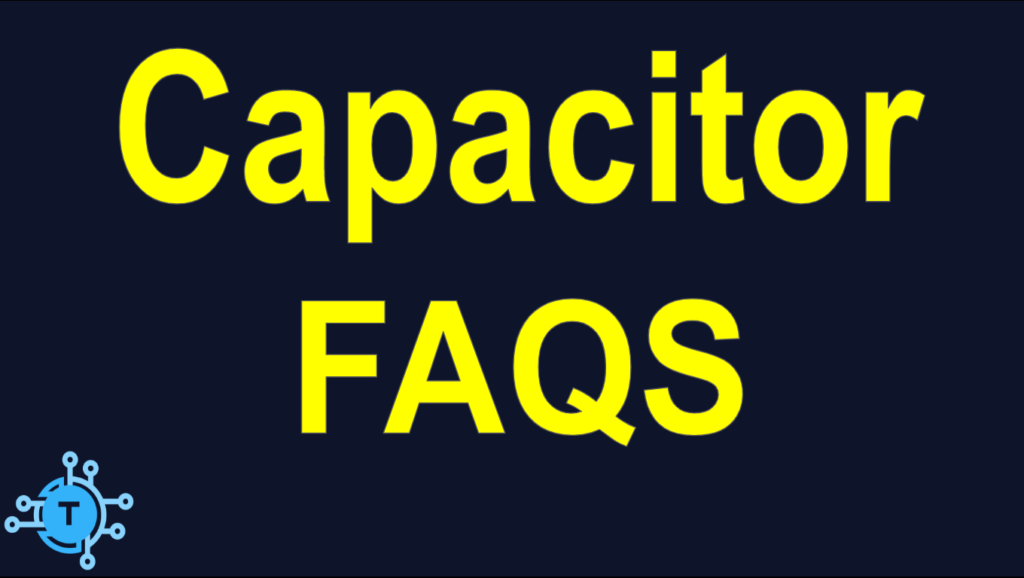
Frequently Asked Questions about Capacitors is another in a series of FAQS about electricity and electronics that are oriented toward Appliance Technicians and HVAC Technicians.
Frequently Asked Questions about Capacitors
Q. What is a capacitor?
A. It is a device that stores electrical energy in the form of an electric field.
Q. How is a capacitor constructed?
A. In its most basic form, it is two metal plates in close proximity separated by an insulator.
Q. How is capacitance measured?
A. In Farads.
Q. What are the key specifications of a capacitor?
A. Capacitance, breakdown voltage, polarity (if applicable), rated hours, and rated temperature.
Q. What is a capacitor used for?
A. Among other functions, it used to store energy, release energy, filter out supply ripple, cause phase-shifting between voltage and current (such as for motor start and run applications), and for power factor correction.
Q. How do capacitors behave in circuits?
A. They resist changes in voltage, which causes a phase shift between voltage and current, where the current leads and the voltage lags (current happens first, then changes in voltage across the capacitor happens next).
Q. How do capacitors oppose current flow?
A. Since they resist changes in voltage, current flows through when that is attempted. The magnitude of that current is proportional to how fast the voltage change is attempted. Thus, the higher the frequency of the AC voltage across a capacitor, the higher the current flow into it – and the lower the capacitive reactance. The lower the AC voltage frequency, the lower the current – and the higher the capacitive reactance. Thus you can say that capacitive reactance is inversely proportional to the supply frequency. Capacitive reactance is a component of impedance.
Q. What are some different types of capacitors?
A. Ceramic, silver mica, film, tantalum, and electrolytic.
Q. How do capacitors fail?
A. Common failure modes are voltage breakdown, leaky, shorted, high ESR, and loss of capacitance.
Q. What is a start capacitor?
A. A capacitor that temporarily shifts the phase of the start/auxiliary winding relative to the main winding, of a single phase induction motor so as to cause a rotating magnetic field that turns the armature.
Q. What is a run capacitor?
A. A permanent capacitor within a motor circuit that causes multi-phase operation in a single-phase induction motor. Such a capacitor shifts the phase of the motor’s auxiliary winding relative to the main winding – providing a rotating magnetic field for the armature.
Q. What is the purpose of a power supply capacitor?
A. It smooths out a pulsating rectified signal, thereby converting it into a DC voltage. This process is also called low-pass filtering. The capacitor accomplishes this by storing the high-peaks of the signal, and releasing that energy as the peaks drop.
Q. What is an electrolytic capacitor?
A. It is a type of capacitor that uses an electrolyte as a conductor on the negative side of the capacitor. The electrolyte both connects the negative terminal to the capacitor plate and comprises the plate itself. This technology, along with the dielectric insulation used, makes for high density of capacitance.
Q. What is an electrolyte?
A. It is a liquid that conducts electricity by physical movement of ions, as opposed to electron displacement (as would occur in a metal conductor).
Q. How do electrolytic capacitors fail?
A. Most often due to drying out of the electrolyte. Here’s the detailed article on electrolytic capacitor failure and testing: https://techcircuit.org/electrolytic-capacitor-failures/
Q. How do you test capacitors?
A. With a capacitance tester or an ESR meter.
Q. What is ESR?
A. ESR, or Equivalent Series Resistance, is an AC measured opposition to current flow that a capacitor presents primarily as a result of internal series resistance, such as resistance in the leads, internal conductors, and most often due to the effective resistance of an electrolyte. For the latter, the effective resistance increases as the electrolytic capacitor ages and/or dries out.
Q. How do capacitors combine to increase or decrease capacitance or voltage?
A. For two series capacitors, the voltage rating adds, while the capacitance is the product over the sum. For two parallel capacitors, the final voltage rating is equal to the lowest voltage rating of the two capacitors. The polarity of combined capacitors must be aligned.
To donate to the Tech Circuit – CLICK HERE
For additional electrical and electronics learning material for field techs, visit our homepage at http://www.TechCircuit.org or our Facebook group at https://www.facebook.com/groups/746823709133603 or our YouTube Channel
at https://www.youtube.com/@TheTechCircuit
TC
We are a participant in the Amazon Services LLC Associates Program, an affiliate advertising program designed to provide a means for us to earn fees by linking to Amazon.com and affiliated sites.
